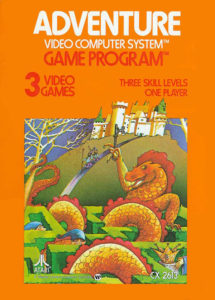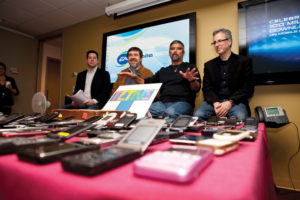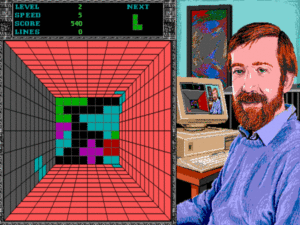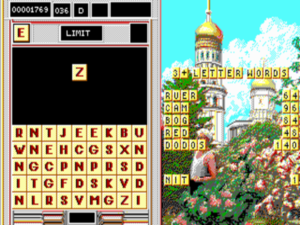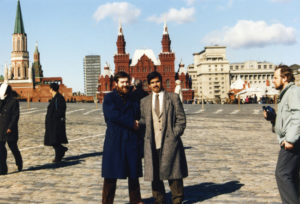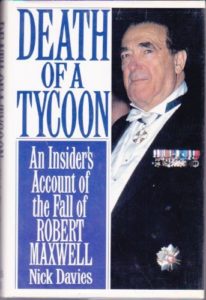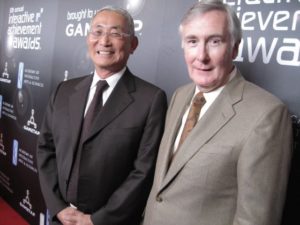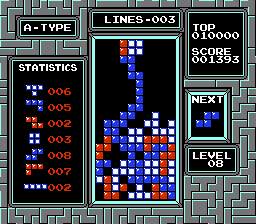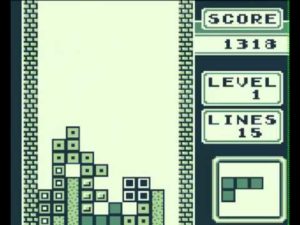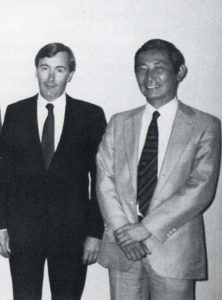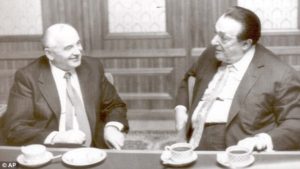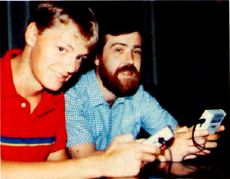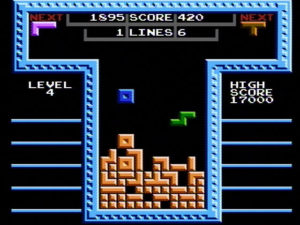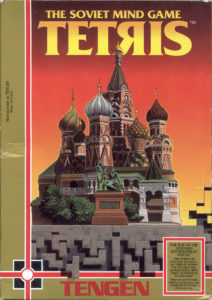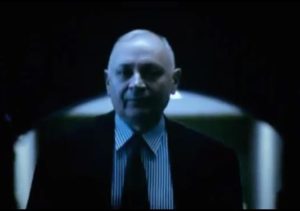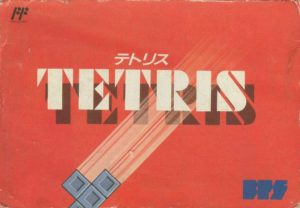As regular readers of this blog are doubtless well aware, we stand now at the cusp not only of a new decade but also of a new era in terms of this history’s internal chronology. The fractious 1980s, marked by a bewildering number of viable computing platforms and an accompanying anything-goes creative spirit in the games that were made for them, are becoming the Microsoft-dominated 1990s, with budgets climbing and genres hardening (these last two things are not unrelated to one another). CD-ROM, the most disruptive technology in gaming since the invention of the microprocessor, hasn’t arrived as quickly as many expected it would, but it nevertheless looms there on the horizon as developers and publishers scramble to prepare themselves for the impact it must have. For us virtual time travelers, then, there’s a lot to look forward to. It should be as exciting a time to write about — and hopefully to read about — as it was to live through.
Yet a period of transition like this also tempts a writer to look backward, to think about the era that is passing in terms of what was missed and who was shortchanged. It’s at a time like this that all my vague promises to myself to get to this story or that at some point come home to roost. For if not now, when? In that light, I hope you’ll forgive me for forcing you to take one or two more wistful glances back with me before we stride boldly forward into our future of the past. There’s at least one more aspect of 1980s gaming, you see, that I really do feel I’d be remiss not to cover in much better detail than I have to this point: the astonishing, and largely British, legacy of the open-world action-adventure.
First, a little taxonomy to make sure we’re all on the same page. The games I want to write about take the themes and mechanics of adventure games — meaning text adventures during most of the era in question — and combine them with the graphics and input methods of action games; thus the name of “action-adventure.” Still, neither the name nor the definition conveys what audacious achievements the best of these games could be. On computers which often still had to rely on cassettes rather than disks for storage, which struggled to run even Infocom-level text adventures, almost universally young programmers, generally working alone or in pairs, proposed to create huge virtual worlds to explore — worlds which were to be depicted not in text but visually, running in organic, fluid real time. It was, needless to say, a staggeringly tall order. The programmers who tackled it did so because, being so young, they simply didn’t know any better. What’s remarkable is the extent to which they succeeded in their goals.
Which is not to say that games in this category have aged as well as, say, the majority of the Infocom catalog. Indeed, herein lies much of the reason that I’ve rather neglected these games to date. As all you regulars know by now, I place a premium on fairness and solubility in adventure-game design. I find it hard to recommend or overly praise games which lack this fundamental good faith toward their players, even if they’re wildly innovative or interesting in other ways.
That said, though, we shouldn’t entirely forget the less-playable games of history which pushed the envelope in important ways. And among the very most interesting of such interesting failures are many games of the early action-adventure tradition.
It’s not hard to pinpoint the reasons that these games ended up as they are. Their smoothly-scrolling and/or perspective-bending worlds make them hard to map, and thus hard for the player to methodically explore, in contrast to the grid-based movement of text adventures or early CRPGs. The dynamism of their worlds in contrast to those of those other genres leave them subject to all sorts of potentially game-wrecking emergent situations. Their young creators had no grounding in game design, were in fact usually far more interested in the world they were creating inside their primitive instruments than they were in the game they were asking their players to solve there. And in this era neither developers nor publishers had much of an inkling about the concept of testing. We should perhaps be more surprised that as many games of this stripe ended up as playable as they are than the reverse.
As I’ve admitted before, it’s inevitably anachronistic to return to these ancient artifacts today. In their own day, players were so awe-struck by these worlds’ very existence that they weren’t usually overly fixated on ending all the fun of exploring them with a victory screen. So, I’m going to relax my usual persnicketiness on the subject of fairness just a bit in favor of honoring what these games did manage to achieve. On this trip back through time, at least, let’s try to see what players saw back in the day and not quibble too much over the rest.
In this first article, we’ll go to the United States to look at the development of the very first action-adventure. It feels appropriate for such a beast to have started life as a literal translation of the original adventure game — Will Crowther and Don Woods’s Adventure — into a form manageable on the Atari VCS game console. The consoles aren’t my primary focus for this history, but this particular console game was just so important for future games on computers that my neglect of it has been bothering me for years.
After this article, we’ll turn the focus to Britain, the land where the challenge laid down by the Atari VCS Adventure was picked up in earnest, to look at some of the more remarkable feats of virtual world-building of the 1980s. And after that, and after looking back at one more subject that’s been sticking in his craw — more on that when the time comes — your humble writer here can start to look forward again from his current perch in the historical timeline with a clearer conscience.
A final note: I am aware that games of this type have a grand tradition of their own in Japan, which arrived on American shores through Nintendo Entertainment System titles like 1986’s The Legend of Zelda. I hope fans of such games will forgive me for neglecting them. My arguments for doing so are the usual suspects: that writing about them really would be starting to roam dangerously far afield from this blog’s core focus on computer gaming, that my own knowledge of them is limited to say the least, and that it’s not hard to find in-depth coverage of them elsewhere.
Adventure (1980)
Like so many others, Warren Robinett had his life changed by Will Crowther and Don Woods’s game of Adventure. In June of 1978, he was 26 years old and was working for Atari as a programmer of games for their VCS console, which was modestly successful at the time but still over a year removed from the massive popularity that would follow. More due to the novelty of the medium and upper management’s disinterest in the process of making games than any spirit of creative idealism, Atari at the time operated on the auteur model of videogame development. Programmers like Robinett were not only expected also to fill the role of designers — a role that had yet to be clearly defined anywhere as distinct from programming — but to function as their own artists and writers. To go along with this complete responsibility, they were given complete control of every aspect of their games, including the opportunity to decide what sorts of games to make in the first place. On Robinett’s first day of work, according to his own account, his new boss Larry Kaplan had told him, “Your job is to design games. Now go design one.” The first fruit of his labor had been a game called Slot Racers, a simple two-player exercise in maze-running and shooting that was very derivative of Combat, the cartridge that was bundled with every Atari VCS sold.
With Slot Racers under his belt, Robinett was expected, naturally, to come up with a new idea for his next game. Luckily, he already knew what he wanted to do. His roommate happened to work at the storied Stanford Artificial Intelligence Lab, and one day had invited him to drop by after hours to play a neat game called Adventure on the big time-shared computers that lived there. Robinett declared it to be “the coolest thing I’ve ever seen.” He decided that very night that he wanted to make his next project an adaptation of Adventure for the Atari VCS.
On the face of it, the proposition made little sense. My description of Robinett’s Slot Racers as derivative of Combat begins to sound like less of a condemnation if one considers that no one had ever anticipated the Atari VCS being used to run games that weren’t built, as Combat and Slot Racers had been, from the simple-minded raw material of the earliest days of the video arcades. The machine’s designers had never, in other words, intended it to go much beyond Pong and Breakout. Certainly the likes of Adventure had never crossed their minds.
Adventure consisted only of text, which the VCS wasn’t terribly adept at displaying, and its parser accepted typed commands from a keyboard, which the VCS didn’t possess; the latter’s input mechanism was limited to a joystick with a single fire button. The program code and data for Adventure took more than 100 K of storage space on the big DEC PDP-10 computer on which it ran. The Atari VCS, on the other hand, used cartridge-housed ROM chips capable of storing a program of a maximum of 4 K of code and data, and boasted just 128 bytes — yes, bytes — of memory for the volatile storage of in-game state. In contrast to a machine like the PDP-10 — or for that matter to just about any other extant machine — the VCS was shockingly primitive to program. There not being space enough to store the state of the screen in those 128 bytes, the programmer had to manually control the electron beam which swept left to right and top to bottom sixty times per second behind the television screen, telling it where it should spray its blotches of primary colors. Every other function of a game’s code had to be subsidiary to this one, to be carried out during those instants when the beam was making its way back to the left side of the screen to start a new line, or — the most precious period of all — as it moved from the end of one round of painting at the bottom right of the screen back to the top left to start another.
The creative freedom that normally held sway at Atari notwithstanding, Robinett’s bosses were understandably resistant to what they viewed as his quixotic quest. Undeterred, he worked on it for the first month in secret, hoping to prove to himself as much as anyone that it could be done.
It was appropriate in a way that it should have been Warren Robinett among all the young programmers at Atari who decided to bring to the humble VCS such an icon of 1970s institutional computing — a rarefied environment far removed from the populist videogames, played in bars and living rooms, that were Atari’s bread and butter. Almost all of the programmers around him were self-taught hackers, masters of improvisation whose code would have made any computer-science professor gasp in horror but whose instincts were well-suited to get the most out of the primitive hardware at their disposal. Robinett’s background, however, was very different. He brought with him to Atari a Bachelor’s Degree in computer science from Rice University and a Master’s from the University of California, Berkeley, and along with them a grounding in the structure and theory of programming which his peers lacked. He was, in short, the perfect person at Atari to be having a go at this project. While he would never be one of the leading lights of the programming staff in terms of maximizing the VCS’s audiovisual capabilities, he knew how to design the data structures that would be necessary to make a virtual world come to life in 4 K of ROM and 128 bytes of RAM.
Robinett’s challenge, then, was to translate the conventions of the text adventure into a form that the VCS could manage. This naturally entailed turning Crowther and Woods’s text into graphics — and therein lies an amusing irony. In later years, after they were superseded by various forms of graphic adventures, text adventures would come to be seen by many not so much as a legitimate medium in themselves as a stopgap, an interim way to represent a virtual world on a machine that didn’t have the capability to display proper graphics. Yet Robinett came to this, the very first graphic adventure, from the opposite point of view. What he really wanted to do was to port Crowther and Woods’s Adventure in all its textual glory to the Atari VCS. But, since the VCS couldn’t display all that text, he’d have to find a way to make do with crude old graphics.
The original Adventure, like all of the text adventures that would follow, built its geography as a topology of discrete “rooms” that the player navigated by typing in compass directions. In his VCS game, Robinett represented each room as a single screen. Instead of typing compass directions, you move from room to room simply by guiding your avatar off the side of a screen using the joystick: north becomes the upper boundary of the screen, east the right-hand boundary, etc. Robinett thus created the first VCS game to have any concept of a geography that spanned beyond what was visible on the screen at any one time. The illustration below shows the text-adventure-like map he crafted for his world.
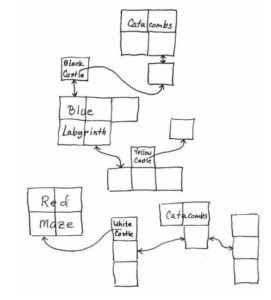 It’s important to note, though, that even such a seemingly literal translation of a text adventure’s geography to a graphical game brought with it implications that may not be immediately obvious. Most notably, your avatar can move about within the rooms of Robinett’s game, a level of granularity that its inspiration lacks; in Crowther and Woods’s Adventure, you can be “in” a “room” like “End of Road” or “Inside Building,” but the simulation of space extends no further. The effect these differences have on the respective experiences can be seen most obviously in the two games’ approaches to mazes. Crowther and Woods’s (in)famous “maze of twisty little passages” is built out of many individual rooms; the challenge comes in charting the one-way interconnections between them all. In Robinett’s game, however, the mazes — there are no less than four of them for the same reason that mazes were so common in early text adventures: they’re cheap and easy to implement — are housed within the rooms, even as they span multiple rooms when taken in their entirety.
It’s important to note, though, that even such a seemingly literal translation of a text adventure’s geography to a graphical game brought with it implications that may not be immediately obvious. Most notably, your avatar can move about within the rooms of Robinett’s game, a level of granularity that its inspiration lacks; in Crowther and Woods’s Adventure, you can be “in” a “room” like “End of Road” or “Inside Building,” but the simulation of space extends no further. The effect these differences have on the respective experiences can be seen most obviously in the two games’ approaches to mazes. Crowther and Woods’s (in)famous “maze of twisty little passages” is built out of many individual rooms; the challenge comes in charting the one-way interconnections between them all. In Robinett’s game, however, the mazes — there are no less than four of them for the same reason that mazes were so common in early text adventures: they’re cheap and easy to implement — are housed within the rooms, even as they span multiple rooms when taken in their entirety.
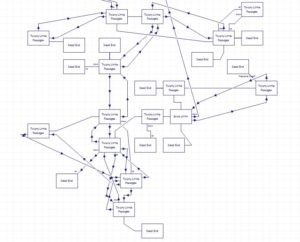
Crowther and Woods’s maze of twisty little passages, a network of confusing room interconnections where going north and then going south usually won’t take you back to where you started.

Warren Robinett’s graphical take on the adventure-game maze; it must be navigated within the rooms as well as among them. The dot at left is the player’s avatar, which at the moment is carrying the Enchanted Chalice whose recovery is the goal of the game.
Beyond the challenges of mapping its geography, much of Crowther and Woods’s game revolves around solving a series of set-piece puzzles, usually by using a variety of objects found scattered about within the various rooms; you can pick up such things as keys and lanterns and carry them about in your character’s “inventory” to use elsewhere. Robinett, of course, had to depict such objects graphically. To pick up an object in his game, you need simply bump into it with your avatar; to drop it you push the fire button. Robinett considered trying to implement a graphical inventory screen for his game, but in the end chose to wave any such tricky-to-implement beast away by only allowing your avatar to carry one item at a time. Similarly, the “puzzles” he placed in the game, such as they are, are all simple enough that they can be solved merely by bringing an appropriate object into the vicinity of the problem. Opening a locked gate, for instance, requires only that the player walk up to it toting the appropriate key; ditto attacking a dragon with a sword. By these means, Robinett pared down the “verbs” in his game to the equivalent of the text parser’s movement commands, its “take” and “drop” commands, and a sort of generic, automatically-triggered “use” action that took the place of all the rest of them. (Interestingly, the point-and-click, non-action-oriented graphical adventures that would eventually replace text adventures on the market would go through a similar process of simplification, albeit over a much longer stretch of time, so that by the end of the 1990s most of them too would offer no more verbs than these.)
The text-to-graphics adaptations we’ve seen so far would, with the exception only of the mazes, seem to make of Robinett’s Adventure a compromised shadow of its inspiration, lacking not only its complexity of play but also, thanks to the conversion of Crowther and Woods’s comparatively refined prose to the crudest of graphics, its flavor as well. Yet different mediums do different sorts of interactivity well. Robinett managed, despite the extreme limitations of his hardware, to improve on his inspiration in certain ways, to make some aspects of his game more complicated and engaging in compensation for its simplifications. Other than the mazes, the most notable case is that of the other creatures in the world.
The world of the original Adventure isn’t an entirely uninhabited place — it includes a dwarf and a pirate who move about the map semi-randomly — but these other actors play more the role of transitory annoyances than that of core elements of the game. With the change in medium, Robinett could make his other creatures play a much more central role. Using an approach he remains very proud of to this day, he gave his four creatures — three dragons and a pesky, object-stealing bat, an analogue to Crowther and Woods’s kleptomaniacal pirate — “fears” and “desires” to guide their movements about the world. With the addition of this basic artificial intelligence, his became a truly living world sporting much emergent possibility: the other creatures continue moving autonomously through it, pursuing their own agendas, whether you’re aware of them or not. When you do find yourself in the same room/screen as one of the dragons, you had best run away if you don’t have the sword. If you do, the hunted can become the hunter: you can attempt to kill your stalker. These combat sequences, like all of the game, run in real time, another marked contrast with the more static world of the Crowther and Woods Adventure. Almost in spite of Robinett’s best intentions, the Atari VCS’s ethos of action-based play thus crept into his staid adventure game.
Robinett’s Adventure was becoming a game with a personality of its own rather than a crude re-implementation of a text game in graphics. It was becoming, in other words, a game that maximized the strengths of its medium and minimized its weaknesses. Along the way, it only continued to move further from its source material. Robinett had originally planned so literal a translation of Crowther and Woods’s Adventure that he had sought ways to implement its individual puzzles; he remembers struggling for some time to recreate his inspiration’s “black rod with a rusty star on the end,” which when waved in the right place creates a bridge over an otherwise impassable chasm. In the end, he opted instead to create a movable bridge object which you can pick up and carry around, dropping it on walls to create passages. Robinett:
Direct transliterations from text to video format didn’t work out very well. While the general idea of a videogame with rooms and objects seemed to be a good one, the graphic language of the videogame and the verbal language of the text dialogue turned out to have significantly different strengths. Just as differences between filmed and live performance caused the art form of cinema to slowly diverge from its parent, drama, differences between the medium of animated graphics and the medium of text have caused the animated adventure game to diverge from the text-adventure game.
So, Robinett increasingly turned away from direct translation in favor of thematic analogues to the experience of playing Adventure in text form. To express the text-based game’s obsession with lighted and dark rooms and the lantern that turns the latter into the former, for instance, he included a “catacombs” maze where only the few inches immediately surrounding your avatar can be seen.
But even more radical departures from his inspiration were very nearly forced upon him. When Robinett showed his work-in-progress, heretofore a secret, to his management at Atari, they liked his innovations, but thought they could best be applied to a game based on the upcoming Superman movie, for which Atari had acquired a license. Yet Robinett remained wedded to his plans for a game of fantasy adventure, creating no small tension. Finally another programmer, John Dunn, agreed to adapt the code Robinett had already written to the purpose of the Superman game while Robinett himself continued to work on Adventure. Dunn’s game, nowhere near as complex or ambitious as Robinett’s but nevertheless clearly sporting a shared lineage with it, hit the market well before Adventure, thereby becoming the first released Atari VCS game with a multi-screen geography. Undaunted, Robinett soldiered on to finish creating the new genre of the action-adventure.
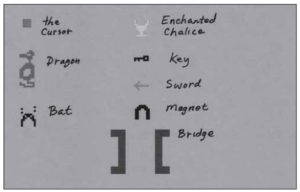
The Atari Adventure‘s modest collection of creatures and objects. The “cursor” represents the player’s avatar. Its shape was actually hard-coded into the Atari VCS, where it was intended to represent the ball in a Pong-like game — a telling sign of the only sorts of games the machine’s creators had envisioned being run on it. And if you think the dragons look like ducks, you’re not alone. Robinett never claimed to be an artist…
Ambitious though it was in contrast to Superman, his graphic-based adventure game of 4 K must be inevitably constrained in contrast to a text-based game of more than 100 K. He wound up with a world of about 30 rooms — as opposed to the 130 rooms of his inspiration — housing a slate of seven totable objects: three keys, each opening a different gate; a sword for fighting the dragons; the bridge; a magnet that attracts to it other objects that may be inaccessible directly; and the Enchanted Chalice that you must find and return to the castle where you begin the game in order to complete it. (Rather than the fifteen treasures of Crowther and Woods’s Adventure, Robinett’s game has just this one.)
The constraints of the Atari VCS ironically allowed Robinett to avoid the pitfall that dogs so many later games of this ilk: a tendency to sprawl out into incoherence. Adventure, despite or perhaps because of its primitiveness, is playable and soluble, and can be surprisingly entertaining even today. To compensate for both his constrained world and the youngsters who formed the core of Atari’s customers, Robinett designed the game with three selectable modes of play: a simplified version for beginners and/or the very young, a full version, and a version that scattered all of the objects and creatures randomly about the world to create a new challenge every time. This last mode was obviously best-suited for players who had beaten the game’s other modes, for whom it lent the $25 cartridge a welcome modicum of replayability.
Thanks to the efforts of Jason Scott and archive.org, Adventure can be played today in a browser. Failing that, the video below, prepared by Warren Robinett for his postmortem of the Atari Adventure at the 2015 Game Developers Conference, shows a speed run through the simplified version of the game — enough to demonstrate most of its major elements.
Robinett finished his Adventure in early 1979, about two years after Crowther and Woods’s game had first taken institutional computing by storm and about eight months after he’d begun working on his videogame take on their concept. (True to his role of institutional computing’s ambassador to the arcade, he’d spent most of that time working concurrently on what seemed an even more impossible task: a BASIC programming system for the Atari VCS, combining a cartridge with a pair of hardware controllers that together formed an awkward keyboard.) From the beginning right up to the date of its release, his game’s name remained simply Adventure, nobody apparently ever having given any thought to the confusion this could create among those familiar with Crowther and Woods’s game. Frustrated by Atari’s policy of giving no public credit to the programmers who created their games, one of Robinett’s last additions was a hidden Easter egg, one of videogaming’s first. It took the form of a secret room housing the only text in this game inspired by a text adventure, spelling out the message “Created by Warren Robinett.” Unhappy with his fixed salary of about $22,000 per year, Robinett left Atari shortly thereafter, going on to co-found The Learning Company, a pioneer in educational software. The first title he created there, Rocky’s Boots, built on many of the techniques he’d developed for Adventure, although it ran on an Apple II computer rather than the Atari VCS.
In the wake of Robinett’s departure, Atari’s marketing department remained nonplussed by this unusually complex and cerebral videogame he had foisted on them. Preoccupied by Atari’s big new game for the Christmas of 1979, a port of the arcade sensation Asteroids, they didn’t even release it until June of 1980, more than a year after Robinett had finished it. Yet the late release date proved to be propitious, coming as it did just after the Atari VCS’s first huge Christmas season, when demand for games was exploding and the catalog of available games was still fairly small. Adventure became something of a sleeper hit, selling first by random chance, plucked by nervous parents off of patchily-stocked store shelves, and then by word of mouth as its first players recognized what a unique experience it really was. Robinett claims it wound up selling 1 million copies, giving the vast majority of that million their very first taste of a computer-based adventure game.
For that reason, the game’s importance for our purposes extends far beyond that of being just an interesting case study in converting from one medium to another. A long time ago, when this blog was a much more casual affair than it’s since become, I wrote these words about Crowther and Woods’s Adventure:
It has long and rightfully been canonized as the urtext not just of textual interactive fiction but of a whole swathe of modern mainstream videogames. (For example, trace World of Warcraft‘s lineage back through Ultima Online and Richard Bartle’s original MUD and you arrive at Adventure.)
I’m afraid I rather let something fall by the wayside there. Robinett’s Adventure, the first of countless attempts to apply the revolutionary ideas behind Crowther and Woods’s game to the more mass-market-friendly medium of graphics, is in fact every bit as important to the progression outlined above as is MUD. [1]As for MUD: don’t worry, I have plans to round it up soon as well.
That said, my next couple of articles will be devoted to charting the game’s more immediate legacy: the action-adventures of the 1980s, which would borrow heavily from its conventions and approaches. While the British programmers we’ll be turning to next had at their disposal machines exponentially more powerful than Robinett’s Atari VCS, they expanded their ambitions exponentially to match. Whether considered as technical or imaginative feats, or both, the action-adventures to come would be among the most awe-inspiring virtual worlds of their era. If you grew up with these games, you may be nodding along in agreement right now. If you didn’t, you may be astonished at how far their young programmers reached, and how far some of them managed to grasp despite all the issues that should have stopped them in their tracks. But then, in this respect too they were only building on the tradition of Warren Robinett’s Adventure.
(Sources: the book Racing the Beam: The Atari Video Computer System by Nick Montfort and Ian Bogost; Warren Robinett’s chapter “Adventure as a Video Game: Adventure for the Atari 2600″ from The Game Design Reader: A Rules of Play Anthology; Next Generation of January 1998; Warren Robinett’s Adventure postmortem from the 2015 Game Developers Conference; Robinett’s interview from Halcyon Days. As noted in the article proper, you can play Robinett’s Adventure in your browser at archive.org.)
Footnotes
| ↑1 | As for MUD: don’t worry, I have plans to round it up soon as well. |
|---|
